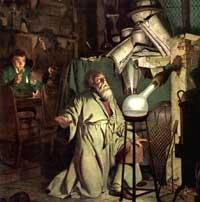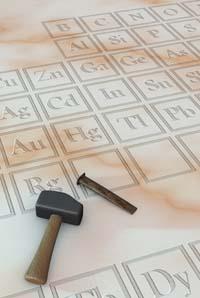Phosphorus: element found in urine
2008/06/29 Álvarez Busca, Lucía - Elhuyar Zientziaren Komunikazioa

Phosphorus is a very reactive element, that is, its atoms are easily mixed with atoms of other elements such as oxygen. The mixture of phosphorus atoms with other elements gives rise to phosphorous compounds. Thus, it is very difficult to find a pure phosphorus in nature. Humans obtain phosphorus artificially from their compounds and from them we extract phosphorus.
Where is phosphorus? It is a very common element in nature. Many rocks contain phosphorous compounds, as well as living beings. There is approximately one kilo of phosphorus in the body of a human being.
But, as we have said, finding pure phosphorus is very difficult. Therefore, they found phosphorus much later than most of the elements. And very curiously.

The German Hennig Brand discovered it by chance in 1669. Brand was alchemist. Therefore, he sought the method of converting non-noble metals into gold, the stone of philosophers. For this purpose, he carried out various experiments. Like many alchemists, I thought that the key to the stone of philosophers could be in the urine.
Brand wanted to get several salts from the urine. For this purpose, the urine was boiled. When all the water evaporated, a solid waste was left in the container. Brand continued to heat the sand. Suddenly, the container was filled with a bright vapour and what was formerly sand became a bright, white liquid. Brand stored this liquid in another container. The liquid was still shining.
Element that carries light
As a result of this surprising phenomenon, Brand called phosphorus the white and bright liquid obtained, because in Greek phosphorus means 'bringing light'. At that time it was called Phosphoros a Venus, because it is very bright seen from the earth.
Brand then tried to improve the process of obtaining phosphorus from the urine. For this purpose, it put the urine to a boil until the liquid evaporates and a viscous residue is obtained. When the sand was heated, a reddish oil was formed. The oil was removed and kept. It allowed to cool the sand that was still in the container. When cooling, two things were obtained: a black and spongy matter on one side and salts on the other. Salt was removed and black matter was mixed with previously obtained reddish oil. Then the mixture was heated for 16 hours. Brand obtained the match of that heated mixture.

But it is the paradox! The phosphorus technique developed by Brand was not the best. In fact, most of the phosphorus found in the urine was found in salts that he did not use, which he withdrew before the mixture. Branden technique requires 5,500 liters of urine to obtain 120 grams of phosphorus. But with the use of eliminated salts it would have achieved much more, since in 5,500 liters of human urine there are more than 7 kilos of phosphorus.
Brand kept its discovery for a time in secret, as it thought that phosphorus could be used to convert non-noble metals such as lead into gold. Of course, he never got it. However, with the passage of time it was announced what achieved by Brand and the new element.
Soon the researchers found that there was also phosphorus in the bones. The bones are crushed and dissolved in acids. They obtained larger amounts than with urine. Currently, neither urine nor bones. Phosphorus is obtained from rocks containing phosphates or phosphorous compounds.
Published in 7K.

Gai honi buruzko eduki gehiago
Elhuyarrek garatutako teknologia





